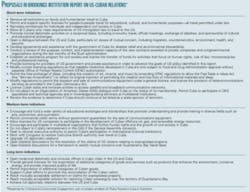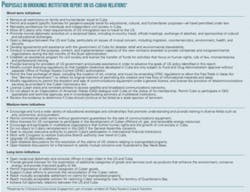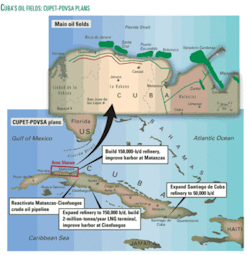A proposal to allow work by US oil and gas companies off Cuba appears in a broad set of recommendations made before President Barack Obama on Apr. 13 eased travel and financial restrictions on the island nation.
A group of former ambassadors, foreign policy specialists, and professors working in a Brookings Institution project on Feb. 26 published 33 steps toward renewal of relations between the two countries in Miami, Fla., home to many Cuban-Americans and the center of opposition to restoration of relations.
A step allowing licenses for US companies to develop offshore oil, gas, and renewable energy is one of 10 “medium-term initiatives” recommended by the 19-member group in its Roadmap for Critical and Constructive Engagement (see table, opposite page). The group’s project is called US Policy toward a Cuba in Transition.
Obama’s move represents a tentative loosening of the trade embargo that the US imposed in 1962 after breaking diplomatic relations with Cuba a year earlier. The US took those steps in response to Fidel Castro’s revolutionary assumption of power in 1959 and alignment with the old Soviet Union.
The US president’s measured overture partly reflects concerns in the US about the power void that will develop when 78-year-old Raul Castro, who succeeded his brother as the Cuban president in February 2008, becomes unable to govern.
Foreign policy officials fear that Cuba without either Castro brother in firm command will become an unstable prize sought by Venezuela’s anti-US President Hugo Chavez, slide back into the orbit of Russian influence, or degenerate into lawlessness subject to exploitation by terrorists and drug cartels (see Comment).
Reliance on Venezuela
Heavy reliance on Venezuela for oil is an evident source of concern in Cuba.
A member of Petrocaribe, the alliance of Caribbean countries that buy oil from Venezuela under preferential terms, Cuba receives 94,000-96,000 b/d from the South American exporter. That’s more than all the other 17 members combined.
Cuba consumes about 150,000 b/d of oil and produces 54,000 b/d of crude oil and natural gas liquids. Gas production is 20,000-22,000 boed.
According to Jorge Pinon, energy fellow at the Center for Hemispheric Policy at the University of Miami and author of the Comment on p. 32, Cuba hasn’t paid for the Venezuelan oil since 2003. The Chavez regime thus holds great leverage over the Cuban government not only as a principal supplier of oil but as a creditor as well.
Pinon points out that worry about Venezuelan influence explains Raul Castro’s recent visits to capitals of other major oil exporters.
Cuba has offered onshore and offshore exploration and production rights to international operators in recent years under production-sharing contracts. Some of the blocks cover deep water of the southeastern Gulf of Mexico (see map, OGJ, Dec. 11, 2000, p. 42).
Repsol YPF in 2004 drilled a deepwater well, the Yamagua-1, in 1,660 m of water that was reported to have indicated oil generation in the basin. Norsk Hydro and ONGC Videsh of India later acquired interests in the block.
Cuba’s existing production comes from onshore and near-shore fields. The oil is heavy—10-15° gravity—and high in sulfur.
Sherritt International, Toronto, is the major non-Cuban producer, accounting for about 30,000 b/d of gross production.
Refining a question
A question for Cuba is what to do with any increase that develops in crude oil production. Its domestic refining capacity is limited, and US sanctions block access to most refineries in the Caribbean.
Cuba’s three refineries have nameplate capacity totaling 288,000 b/d. But they don’t achieve operating rates anywhere near nameplate levels.
The Havana refinery, formerly Shell-Esso, has capacity of 121,000 b/d but operates at only about 20,000 b/d and probably will be closed. The refinery formerly owned by Texaco at Santiago de Cuba has capacity of 101,000 b/d but operates at about 22,000 b/d.
The 66,000-b/d Cienfuegos refinery has been operating at 53,000 b/d. It has 8,000 b/d of hydrotreating, 8,000 b/d of catalytic reforming, and 10,0000 b/d of light ends fractionation capacities.
According to Oil & Gas Journal’s Worldwide Refining survey, the Havana facility is the only one of the three refineries with significant conversion capacity—14,700 b/d of catalytic cracking.
Venezuela has asserted plans to invest $10 billion in downstream projects in Cuba by 2015 through a unit of state-owned Petroleos de Venezuela SA working with its Cuban counterpart, Cubapetroleo SA (Cupet). With oil prices low, however, there are questions whether all or any of the projects will be funded (see map).
At Cienfuegos, the Venezuelan government proposes to spend $3.7 billion to expand crude oil distillation capacity to 150,000 b/d and add a delayed coker. The completion target is 2012.
Also at Cienfuegos, Venezuela proposes to build an LNG terminal with two 1 million-tonne/year trains at an estimated cost of $440 million. The terminal would start up in 2013.
It plans to expand the Santiago de Cuba refinery to 50,000 b/d of crude capacity and add heavy bottoms conversion capacity by 2013.
Venezuela proposes to build a 150,000 b/d refinery at Matanzas with 75,000 b/d of upgrading capacity for heavy Cuban crudes. The refinery, estimated to cost $4.3 billion, would start up in 2015.
Other proposals include improvements to the Matanzas and Cienfuegos harbors, reactivation of a crude oil pipeline between the cities, and new crude and products storage. Those projects, estimated to cost $1.6 billion, would be completed by 2012.
Obama’s move
The US president’s initiative on Apr. 13 included nothing directly related to oil and gas.
While criticized by observers who want no warming of US relations at all with Cuba, the move implemented only a handful of the recommendations put forward by the Brookings project.
Here are elements of Obama’s latest initiative:
- Lift all restrictions on transactions related to the travel of family members to Cuba.
- Remove restrictions on remittances to family members in Cuba.
- Authorize US telecommunications network providers to enter into agreements to establish fiber-optic cable and satellite telecommunications facilities linking the US and Cuba.
- License US telecommunications service providers to enter into roaming service agreements with Cuba’s telecommunications service providers.
- License US satellite radio and satellite television service providers to engage in transactions necessary to provide services to customers in Cuba.
- License persons subject to US jurisdiction to activate and pay US and third-country service providers for telecommunications, satellite radio, and satellite television services provided to individuals in Cuba.
- Authorize the donation of certain consumer telecommunication devices without a license.
- Add certain humanitarian items to the list of items eligible for export through licensing exceptions.
Obama’s only other public step concerning Cuba so far has been his January executive order on closure within 1 year of detention facilities at Guantanamo Bay Naval Base and disposition of 300 suspected terrorists held there as enemy combatants.
That move didn’t specify whether the base itself would be closed or in other ways address sovereignty issues central to the Brookings Institution recommendations.




